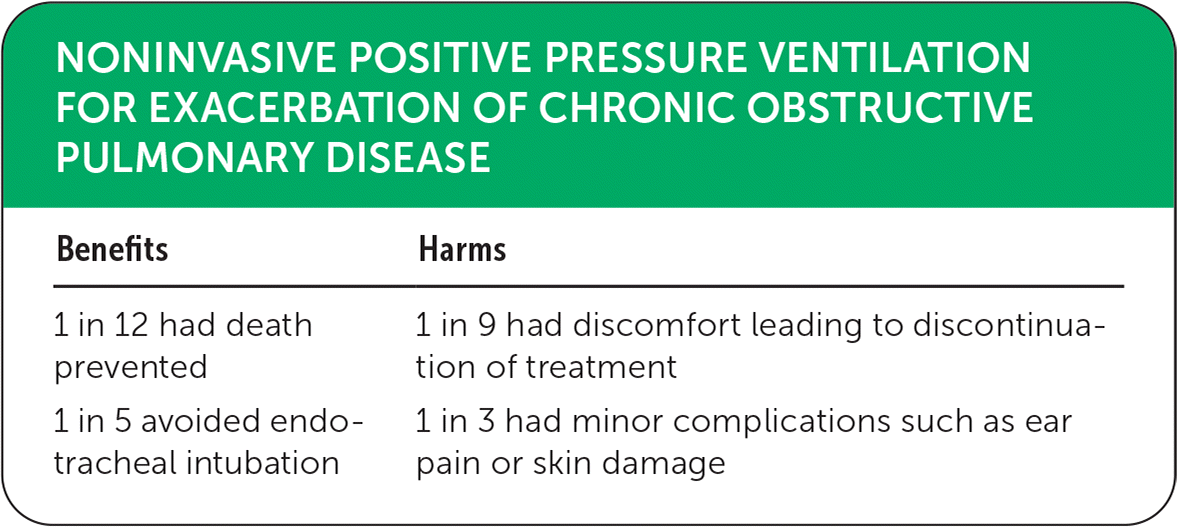
Am Fam Physician. 2020;101(11):online
Author disclosure: No relevant financial affiliations.

Details for This Review

| Benefits | Harms |
|---|---|
| 1 in 12 had death prevented | 1 in 9 had discomfort leading to discontinuation of treatment |
| 1 in 5 avoided endotracheal intubation | 1 in 3 had minor complications such as ear pain or skin damage |
Study Population: Adults with hypercapnic respiratory failure caused by exacerbation of chronic obstructive pulmonary disease (COPD)
Efficacy End Points: Death prevention; reduced endotracheal intubation; shorter duration of hospital stay
Harm End Points: Discomfort leading to discontinuation of treatment; minor complications such as ear pain and skin damage
Narrative: COPD is a progressive lung disease characterized by hyperinflation of the lungs, including emphysema and chronic bronchitis. COPD death rates in the United States have declined since 1999, predominantly in males.1 Endotracheal intubation with ventilatory support for severe exacerbations is difficult to reverse. Noninvasive positive pressure ventilation (NIPPV), if effective in avoiding endotracheal intubation, could, therefore, save lives and reduce suffering.
Of the 17 studies in the Cochrane review,1 all were randomized trials with parallel group design, comparing usual care plus NIPPV to usual care alone, with some variations in usual care. NIPPV was delivered via face mask, nasal mask, or either based on preference.1 A total of 1,264 adults with severe COPD exacerbation and hypercapnic respiratory failure (pH < 7.35; partial pressure of carbon dioxide > 45 mm Hg [6.0 kPa]) were enrolled.
NIPPV reduced both primary outcomes, including death (odds ratio [OR] = 0.4; 95% CI, 0.3 to 0.5; absolute difference = 8.4%; number needed to treat [NNT] = 12) and endotracheal intubation (OR = 0.4; 95% CI, 0.3 to 0.5; absolute difference = 22%; NNT = 5). Length of hospital stay was also shorter with NIPPV (mean difference = 3 days; 95% CI, 1 to 6).1
Inability to comply with treatment was higher in the NIPPV group (absolute difference = 11%; 95% CI, 4% to 17%; number needed to harm [NNH] = 9). Complications due to NIPPV (i.e., ear pain, skin breaks caused by the mask, and other minor issues) occurred in nearly one in three patients (NNH = 3). However, overall there were fewer complications unrelated to NIPPV (relative risk = 0.3; 95% CI, 0.1 to 0.5; N = 2 studies).
Caveats: The review authors rated the quality of evidence as moderate, mostly based on a lack of blinding, which is inevitable because of the nature of NIPPV. However, they also stated this is unlikely to have affected primary outcomes.1
The efficacy of NIPPV is dependent on tolerance. For every nine patients treated, one was unable to tolerate NIPPV. Therefore, successful treatment requires a conscious, cooperative patient. Another consideration is difficulty accessing airways due to the mask. This could limit suctioning secretions and result in aspiration or atelectasis, although these data suggest such complications were not more common with NIPPV.1
After the publication of this Cochrane review, the European Respiratory Society and American Thoracic Society published practice guidelines for NIPPV in patients with COPD during acute exacerbation.2 These guidelines advise against NIPPV to prevent respiratory acidosis but recommend it for treating acute respiratory acidosis (pH < 7.35). They also recommend NIPPV for those with severe acidosis and severe distress, as an alternative to invasive ventilation.
NIPPV reduces mortality and endotracheal intubation in hypercapnic respiratory failure caused by COPD exacerbation. Inability to comply with treatment is higher with NIPPV. However, unrelated complications are less common, and related complications are typically minor. Because of major benefits and the absence of serious harms, we have assigned a color recommendation of green for this intervention.
Copyright © 2020 MD Aware, LLC (theNNT.com). Used with permission.
This series is coordinated by Dean A. Seehusen, MD, MPH, AFP assistant medical editor, and Daniel Runde, MD, from the NNT Group.
A collection of Medicine by the Numbers published in AFP is available at https://www.aafp.org/afp/mbtn.
